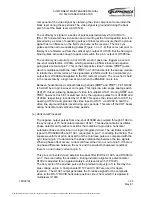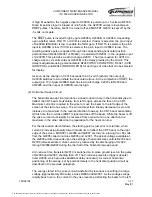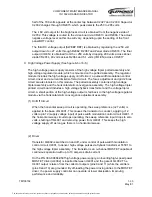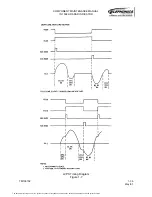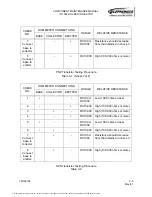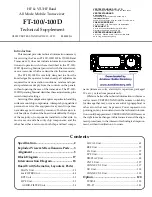
COMPONENT MAINTENANCE MANUAL
IN 1502H RADAR INDICATOR
TM109102
1-29
May/01
The pincushion correction output from U2004A is also routed to the vertical circuit
where a portion of the correction voltage is used to compensate for non-linearities in
the vertical yoke.
(5) Vertical Sweep Circuit
The vertical sweep circuit is simpler than the horizontal sweep circuit because it
operates at a much lower frequency. The circuit is a Class-A amplifier in an integrator
loop. It includes an override switch that dumps +65 volts to the vertical deflection yoke
during Y retrace. The circuit generates a ramp that slopes from b12 volts and
-12 volts to sweep the beam, from the top of the screen to the bottom.
Operational amplifier U2005 feeds the power amplifier formed by Q2002 and Q2003.
Transistor Q2001 is the override switch that is turned on at Y-retrace time. These
transistors are complementary Darlington power transistors. The circuit integrates the
Y-retrace (YRET) pulse into a ramp voltage at TP2004. The inductive load, the vertical
yoke, is inside the feedback loop. Therefore, the yoke current is proportional to the
voltage across R2019 (TP2002). The capacitive feedback is shorted by analog switch
U2003A during Y-retrace, dumping about +65 volts (-0501) or +53 volts (-0503) to the
yoke via Q2001 and Q2002. After Y-retrace, Q2001 switches off and the ramp slopes
from a positive value to a negative value via Q2002 and Q2003, respectively. Zero
volts represent the vertical center of the screen.
An offset is provided to U2005 by R2017, the vertical position control, and by R2013
when CCIR video is selected or R2022, when RS170 video is selected. These
potentiometers move the display up or down. The amplitude of the ramp generated is
controlled by the vertical size controls, R2006 (radar), R2004 (CCIR), and R2005
(RS-170).
The ramp current generated by the vertical sweep generator is linear. However,
because of non-linearity introduced by the CRT geometry, a portion of the pincushion
correction voltage is applied to the vertical sweep circuit. The pincushion correction
voltage output from U2004A is applied to operational amplifier U2004B, which is
configured for a gain of 0.1. The output of U2004B is summed with the voltage at the
input to U2005 to provide the necessary raster correction.
(6) DC Voltage Outputs
Four DC voltage outputs from the sweep module are derived from the horizontal
sweep circuit. A +250-volt (nominal) output is supplied to the degaussing circuit on the
video/RS170 module. A -160 volt (nominal) output is supplied to the brightness circuit,
also on the video/RS-170 module. The SWEEP REF output (+27 volts) enables the
high voltage supply. If the horizontal sweep is lost, this output will go to zero volts and
shut off the high voltage supply to protect against possible CRT damage. The VID EN
output (+5.l volts) shuts down the video circuits on the video/RS-170 module if the
horizontal sweep is lost.
During X-retrace, transistors Q2006 and Q2007 are switched off, producing the
flyback pulse as already explained. The positive side of C2027 swings to about +700
volts and back to zero in about 11 microseconds (X-retrace time). Approximately one
The document reference is online, please check the correspondence between the online documentation and the printed version.











